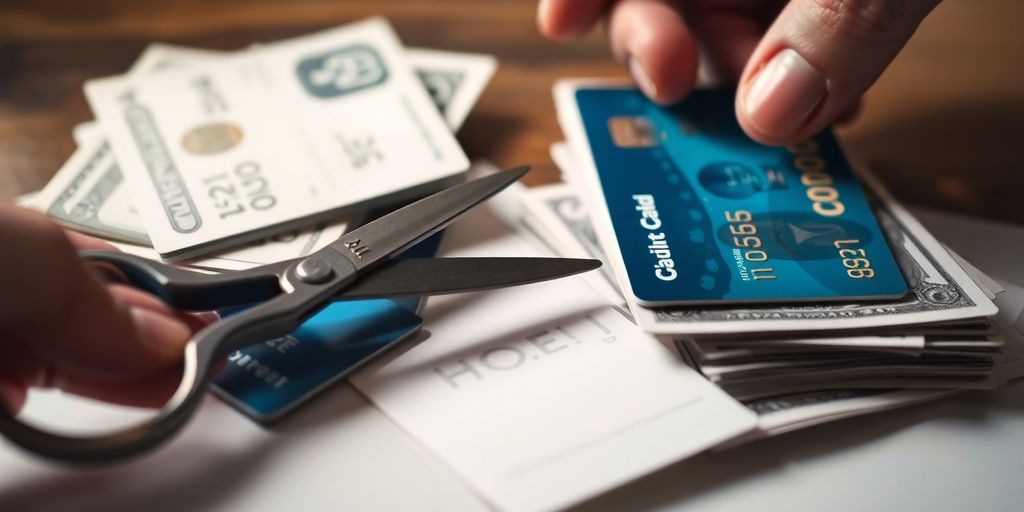
Breaking the Cycle: How to Stop Living Paycheck to Paycheck
Living paycheck to paycheck is something many folks know all too well. You get paid, cover the bills, and poof, the money's gone. It's like a never-ending loop of stress and worry. But it doesn't have to stay this way. By making a few changes, you can break free and start feeling more in control of your finances. Let's dive into some key takeaways that can help you stop living paycheck to paycheck and start building a more secure financial future.
Key Takeaways
- Start by understanding your spending habits and create a realistic budget that covers essentials first.
- Build an emergency fund to handle unexpected expenses without derailing your budget.
- Look for ways to increase your income, like side gigs or asking for a raise at work.
- Focus on paying off debt to free up more of your income each month.
- Live below your means by making conscious spending choices and avoiding lifestyle inflation.
Understanding the Paycheck-to-Paycheck Cycle
The Psychological Impact of Financial Stress
Living paycheck to paycheck isn't just a financial strain—it takes a toll on your mental health too. Constantly worrying about money can lead to anxiety and depression. You might feel trapped in a cycle of stress and uncertainty, unsure of how to break free. Over time, this stress can affect your relationships and overall well-being. It's like carrying a heavy backpack every day, and it's exhausting.
Common Traps That Keep You Stuck
There are several common pitfalls that keep people stuck in this cycle. First, there's the trap of lifestyle inflation—when your expenses rise with your income. Then, there's the reliance on credit cards to make ends meet, which can lead to mounting debt. Finally, impulsive spending on non-essentials can drain your wallet before you realize it.
- Lifestyle Inflation: As your income increases, so do your expenses.
- Credit Card Reliance: Using credit to cover basic needs leads to debt.
- Impulsive Spending: Buying non-essentials can quickly deplete your funds.
Recognizing the Signs of Financial Strain
It's crucial to recognize the warning signs of financial strain before it spirals out of control. Are you frequently overdrawing your account? Do you find yourself juggling bills and deciding which ones to pay late? Or maybe you're borrowing money from friends or family to get by. These are red flags that you need to reassess your financial habits.
"When you're constantly counting down the days to payday, it's a sign that something needs to change. Recognizing these signs is the first step towards gaining control over your finances."
Creating a Sustainable Budget
Identifying Essential and Non-Essential Expenses
When you're trying to make a budget that works, the first step is figuring out what you absolutely need to spend money on and what you can live without. Start by listing out your expenses.
- Essentials: Think of things like rent or mortgage, utilities, groceries, and transportation. These are non-negotiable.
- Non-Essentials: This includes dining out, subscriptions, and entertainment. While these are nice to have, they aren’t necessary.
By separating these expenses, you'll get a clearer picture of where your money is going and where you can cut back if needed.
The Importance of Zero-Based Budgeting
Zero-based budgeting is a method where every dollar you earn is assigned a specific purpose. The goal is to make your income minus your expenses equal zero. This doesn't mean you spend every dollar, but rather, you plan where each dollar goes, whether it's towards savings, paying off debt, or daily expenses.
Here's how to start:
- Calculate your monthly income.
- List all your expenses.
- Subtract expenses from income.
- Adjust until the balance is zero.
This method ensures you're intentional with your money and helps prevent overspending.
Tools and Apps to Simplify Budgeting
In today's digital age, there's no shortage of tools to help manage your finances. Here are a few popular ones:
- Mint: Tracks your spending and helps create a budget automatically.
- You Need a Budget (YNAB): Focuses on zero-based budgeting and helps you break the paycheck-to-paycheck cycle.
- EveryDollar: A simple app to plan your monthly budget and track spending.
Using these tools can make budgeting less of a chore and more of a habit. They provide insights into spending patterns and help you stay on track with your financial goals.
Creating a sustainable budget isn't just about cutting costs; it's about making your money work for you. By understanding your spending habits and using the right tools, you can take control of your finances and break free from the paycheck-to-paycheck cycle.
Building an Emergency Fund
Why an Emergency Fund is Crucial
Imagine you're cruising through life, and suddenly, bam! The car breaks down, or you lose your job. Without a financial cushion, these unexpected events can really throw you off balance. That's where an emergency fund comes in. It's your safety net, your financial buffer against life's curveballs. Having a dedicated stash of cash means you won't need to rely on credit cards or loans, which can lead to debt spirals. Think of it as a personal insurance policy that you control.
Steps to Start Saving Today
- Set a Realistic Goal: Start by aiming for a small, manageable amount, like $1,000. It might sound like a lot, but breaking it down into smaller chunks makes it easier.
- Automate Your Savings: Set up automatic transfers from your checking account to your savings. Treat it like a non-negotiable bill.
- Cut Unnecessary Expenses: Look at your monthly spending. Do you really need that extra streaming service or daily coffee shop run?
- Sell Unused Items: Have a garage sale or sell items online. It's a quick way to boost your savings.
How Much Should You Save?
The ultimate goal? Aim for three to six months' worth of living expenses. This might seem daunting, but remember, it's a long-term goal. Start small and gradually increase your savings. Here's a simple table to help you calculate:
| Monthly Expenses | Emergency Fund Goal (3 Months) | Emergency Fund Goal (6 Months) |
|---|---|---|
| $2,000 | $6,000 | $12,000 |
| $3,000 | $9,000 | $18,000 |
| $4,000 | $12,000 | $24,000 |
Building an emergency fund isn't just about saving money. It's about peace of mind. Knowing you're prepared for the unexpected can reduce stress and help you focus on other financial goals.
Strategies to Increase Your Income
Finding ways to boost your income can be a game-changer, especially if you’re feeling stuck financially. Let’s explore some practical strategies that can help you bring in more cash.
Exploring Side Hustles and Gig Work
Side hustles are a fantastic way to earn extra money without giving up your day job. Think about what you’re good at or what you enjoy doing. Whether it’s driving for a rideshare company, selling handmade crafts, or freelancing in your field of expertise, there’s likely a market for it. The key is to find something that fits into your schedule and doesn’t feel like a burden.
- Identify your skills: Are you good at graphic design, writing, or coding? Use these talents to freelance.
- Consider local opportunities: Babysitting, dog walking, or house cleaning can be lucrative.
- Online platforms: Websites like Etsy, Fiverr, or Upwork can connect you with clients.
Negotiating a Raise at Your Current Job
Asking for a raise can be nerve-wracking, but it’s often necessary if you want to increase your income. Preparation is crucial here. Gather evidence of your achievements and contributions to the company.
- Do your research: Know the industry standards for your position.
- Build your case: Highlight your accomplishments and how they’ve benefited the company.
- Practice your pitch: Be confident and clear about why you deserve a raise.
Turning Hobbies into Income Streams
Your hobbies might be more than just a way to relax—they could be a source of income too. Whether it’s photography, baking, or gardening, there’s potential to monetize what you love doing.
- Photography: Offer services for events or sell prints online.
- Baking: Start a small business catering to local events or markets.
- Gardening: Sell plants or offer landscaping services.
Sometimes, the best income opportunities come from the things you’re already passionate about. By turning your hobbies into a business, you’re not just making money—you’re doing what you love.
Increasing your income is about finding opportunities that align with your skills and interests. Whether it’s a side hustle, asking for a raise, or monetizing a hobby, there’s a path out there that can help you break the paycheck-to-paycheck cycle.
Eliminating Debt for Financial Freedom

Understanding the Debt Snowball Method
The debt snowball method is a popular way to tackle debt. You start by listing all your debts from smallest to largest. Focus on paying off the smallest one first, while making minimum payments on the others. Once the smallest debt is gone, take the money you were paying on it and add it to the next smallest debt. This method builds momentum, helping you stay motivated as you see debts disappear one by one.
Avoiding New Debt While Paying Off Old
It's crucial to stop accumulating new debt while you're trying to pay off the old ones. This means saying no to credit cards, avoiding new loans, and resisting the temptation of buy now, pay later plans. Stick to a budget, enhance your emergency fund, and plan your expenses carefully to avoid falling back into debt.
The Long-Term Benefits of Being Debt-Free
Living without debt offers numerous benefits. You gain control over your finances, reduce stress, and have more money to save and invest. Imagine what you could do with the money you're currently using to pay off debt. Once you're debt-free, you can start building wealth and working towards other financial goals like buying a home or saving for retirement.
Debt can feel like a heavy weight on your shoulders, but taking steps to eliminate it can bring a sense of freedom and peace. Start small, stay consistent, and enjoy the progress as you move towards a debt-free life.
Living Below Your Means
The Benefits of Minimalist Living
Living with less doesn't mean living without joy. In fact, embracing a minimalist lifestyle can lead to a more fulfilling life. Minimalism is about prioritizing what truly matters and eliminating the excess that weighs you down. By focusing on essential items and experiences, you can reduce stress and increase your financial freedom. Consider these benefits:
- Less clutter means less stress and more peace of mind.
- Fewer possessions lead to more time and energy for meaningful activities.
- Financial savings from not buying unnecessary items can be redirected to savings or investments.
How to Make Frugal Choices Daily
Making frugal choices is about being intentional with your spending. Here are some daily habits to help you save money:
- Plan your meals to avoid the temptation of eating out. This not only saves money but also encourages healthier eating.
- Review your subscriptions and cancel those you don't use regularly. Those small monthly fees add up over time.
- Shop with a list to prevent impulse buys and stick to your budget.
Avoiding Lifestyle Inflation
Lifestyle inflation happens when your spending increases as your income rises. To prevent this, it's crucial to revisit your budget regularly and make sure you're living below your means. Here’s how you can avoid it:
- Set a savings goal every time you get a raise, ensuring that a portion of your increased income goes into savings.
- Resist the urge to upgrade your lifestyle with every new paycheck. Instead, focus on long-term financial goals.
- Remember, more money doesn't equate to more happiness. Prioritize experiences and relationships over material possessions.
"Living below your means isn't about depriving yourself; it's about making conscious choices that align with your values and long-term goals."
Staying Motivated on Your Financial Journey

Keeping your spirits up while managing finances can be tough. It's essential to stay motivated as you work towards financial freedom. Here's how you can do it:
Setting Short and Long-Term Goals
Setting both short and long-term goals gives you a roadmap to follow. Short-term goals are like those little wins that keep you going. They might include saving a specific amount each month or cutting back on eating out. Long-term goals, on the other hand, are your big dreams. Maybe it's buying a house or retiring early. Having clear goals makes it easier to stay on track.
Celebrating Small Wins
Don't wait until you hit the big milestones to celebrate. Recognize and reward yourself for the small victories along the way. Paid off a credit card? Treat yourself to something small. Saved up for a vacation? Time to plan it out. Celebrating these wins keeps you motivated and reminds you that progress is happening.
Finding a Support System
Having a support system is crucial. Whether it's friends, family, or a community group, sharing your journey with others can provide encouragement and accountability. Regular check-ins and discussions about your financial journey can help keep you on track and motivated. Plus, sharing your successes and setbacks with others can make the whole process feel less lonely.
Remember, the journey to financial freedom is a marathon, not a sprint. Stay patient, keep pushing forward, and don't forget to enjoy the ride.
Conclusion
Breaking free from the paycheck-to-paycheck grind isn't easy, but it's definitely doable. It's about making small, consistent changes that add up over time. Start with a budget, cut unnecessary expenses, and maybe find ways to boost your income. Remember, it's not just about the numbers—it's about changing how you think about money. Keep your goals in sight and stay motivated. It might be tough now, but the peace of mind you'll gain is worth every bit of effort. You deserve to live without the constant stress of financial worry, so take that first step today.
Frequently Asked Questions
What does living paycheck to paycheck mean?
Living paycheck to paycheck means using most or all of your monthly income to cover expenses, leaving little to no savings for emergencies or future goals.
How can I start saving money if I live paycheck to paycheck?
Begin by creating a budget to track your spending. Identify areas where you can cut back, even if it's just a little, and put that money into savings.
What is a zero-based budget?
A zero-based budget is a method where you allocate every dollar of your income to expenses, savings, or debt repayment, so that your income minus your expenses equals zero.
Why is an emergency fund important?
An emergency fund is crucial because it provides a financial safety net for unexpected expenses, like medical bills or car repairs, without going into debt.
How can I increase my income to break the cycle?
Consider taking on a side job, selling unused items, or asking for a raise at work. Every little bit helps in building your savings.
What is the debt snowball method?
The debt snowball method involves paying off your smallest debts first while making minimum payments on larger ones. This builds momentum and motivation as you see debts disappear.